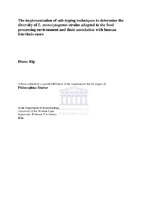| dc.description.abstract | Listeria monocytogenes has been established as a food-borne pathogen since the early 1980s and has become a big concern for the food industry and Public Health authorities (Doyle 2001; Oliveira et al. 2003; Capita et al. 2005; Conly and Johnston 2008). It is a Gram-positive, opportunistic facultative intracellular bacterium which is frequently present in nature and may be found in any food environment (Liu 2006; Chen et al. 2007; Conly and Johnston 2008). Of the six species of Listeria, L. monocytogenes is the only one capable of causing listeriosis, a severe food-borne illness in humans (de Vasconcelos et al. 2008). For the average healthy person, although the incidence of infection is low, symptoms of febrile gastroenteritis may be presented (Gianfranceschi et al. 2007; Kersting et al. 2010). In immunocompromised individuals however, the hospitalization
and mortality rates are amongst the highest for pathogenic organisms (Tran and Kathariou 2002; Lin et al. 2006; Schuppler and Loessner 2010). Illnesses such as septicaemia and central nervous system infections may also occur in these individuals (Roberts et al. 2006; Schuppler and Loessner 2010). Pregnant women and their fetus are also largely at risk where pre-term delivery and birth defects may occur as a result of listeriosis (Doyle 2001; Garrido et al. 2008). The epidemiological surveillance systems for the reporting of listeriosis are poor as it is a non-notifiable disease in many countries. Therefore, the incidence of infection that is regarded as low must be reconsidered
(Mammina et al. 2009; Pinto et al. 2010). Listeria monocytogenes can reproduce in a wide variety of reservoirs within food processing plants, thereby contaminating the food which then poses a risk for food-borne
illness. It can be transmitted from infected animals to humans and also through the consumption of foods from animal origin (Kalender 2003; Kersting et al. 2010). Animals are infected by Listeria spp. found in the environment; the organism is then transmitted through the blood, milk and excrement of the animal back into the environment where manure, soil, feed and water can become contaminated again (Akpolat et al. 2004; Kersting et al. 2010). Poultry products and ready-to-eat (RTE) food that support the
growth of L. monocytogenes, including soft cheeses, unpasteurized milk, hotdogs, deli meats, vegetables and fruits have been linked to cases of listeriosis (Rørvik et al. 2003; Chen et al. 2007; Conly and Johnston 2008; Ford 2010; Kersting et al. 2010). Regardless of HACCP systems that are in place in the food processing plants, listeriosis outbreaks still occur as a result of the ingestion of these food products. Serotyping, based on the serological reaction between somatic (O) and flagellar (H) antigens and their corresponding sera, has identified 13 L. monocytogenes serotypes
(Nadon et al. 2001; Wiedmann 2002; Kérouanton et al. 2010). Of the 13 serotypes of L. monocytogenes, 1/2a, 1/2b and 4b are responsible for more than 95% of listeriosis infections in humans (Mereghetti et al. 2002; Moorhead et al. 2003; Borucki et al. 2004;de Vasconcelos et al. 2008). L. monocytogenes serotypes 1/2a and 1/2b are mainly associated and isolated sporadically from food and 4b is responsible for the major human epidemic cases (Gilbreth et al. 2005). L. monocytogenes serotypes 1/2a and 1/2b are also responsible for sporadic cases of human illness (Wiedmann 2002). | en_US |

